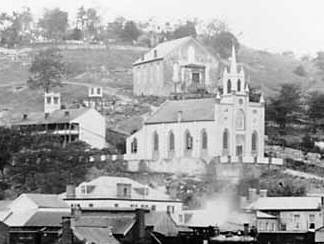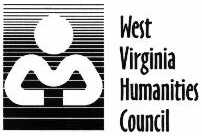This web site and related links provide archaeological and historical research concerning 18th and 19th century sites in Harpers Ferry, West Virginia, and nearby Loudoun Valley, Virginia, as well as the broader region of the upper Potomac and northern Shenandoah Valleys. The author is an anthropologist and lawyer (MA, U. Penn., 1986; JD, Georgetown, 1989; PhD, U. Va., 2003), with research interests in historical archaeology, American history, and African diaspora studies. |
Excavations & Research of | |
St. Peter's Catholic Church, which is listed on the National Register of Historic Places, was built in the early 1830s and has been an important religious institution and social center within Harpers Ferry for over a century and a half. The site includes the standing Church, a Rectory, a nearby privy structure, and the surrounding grounds. The Rectory building was originally a School House which served as a non-denominational educational center from 1854 through 1889, when it was converted into use as housing and offices for the clergy and their staff. |
 St. Peter's Church and Rectory, 1890 |
From the 1950's through the mid-1990's, the National Park Service conducted extensive archaeological and historical research on many of the properties located throughout Lower Town, Harpers Ferry and nearby Virginius Island. However, due to their location on private property, no such archaeological investigations of the grounds of St. Peter's Church and School were undertaken in the course of those investigations. The Church and School grounds potentially offered a wealth of archaeological data on the daily lives and material culture of the Church pastors, support staff, teachers, students, parishioners, and neighbors, for the time period of 1830 onward. Regular services at St. Peter's were curtailed in 1995, as part of a reorganization plan of the Diocese of Wheeling-Charleston. This plan calls for the preservation of the Church in view of its historical significance. St. Peter's remains open to the public, and receives hundreds of thousands of visitors a year, many of whom come to tour the surrounding Harpers Ferry National Historical Park. I conducted excavations on the grounds of the Church and School in the summer of 2000. I have undertaken this project in cooperation with Reverend Father Brian Owens, the Pastor of St. James Church in Charles Town and of St. Peter's, who is working to coordinate restoration work on the buildings and surrounding grounds. This work will likely include improvements of the landscape and repairs to the Church, Rectory and the stone retaining walls that surround them. I organized archaeological investigations to coincide with those efforts in order to preserve the record of artifacts located on those grounds. |
Use the following links to learn more about St. Peter's, our research and excavation project, the landscape of the Harpers Ferry region, and the National Park Service's archaeological work at Harpers Ferry. |
| |
| |
I organized and conducted these excavations with the help of volunteers, during June and July, 2000. Our volunteers were trained in the tasks of conducting historic period excavations and presented with lectures and discussions on the subjects of relevant archaeological methods and theory, historical information related to St. Peter's, the town of Harpers Ferry, and the purposes of our research and excavations. We are combining the use of archaeological investigations, information from historic-period documentary sources (such as wills, deeds, newspaper articles, school and church records, and past photographs), and oral history accounts of past events and their significance, to obtain the richest view possible of the past life ways of those who used and shaped these social, educational and religious meeting places over time. |
To date, we have excavated 26 units (which are three feet square in size) and over 50 shovel test pits (typically one foot wide) in the areas surrounding the old School House. We uncovered thousands of artifacts, including an array of 19th century ceramic types, iron hardware, two religious artifacts, and various materials from later time periods as well. We have not yet excavated the privy structure, because we found a fine young rattlesnake has taken up residence there. We will start excavations on the privy and the surrounding area, if appropriate, after we devise a safe way to relocate this local inhabitant to a new residence elsewhere. Our ongoing research in 2001 will also focus on obtaining more information from past documents, such as local newspapers and the operating records of the School and Church. |
I wish to express sincere gratitude to a wonderful team of volunteers working on this project, many of whom traveled great distances to participate. Our volunteers, coming from California, England, Louisiana, Maryland, Michigan, Minnesota, New York, Ohio, Pennsylvania, Virginia, West Virginia and Wisconsin, include: |
| Gary Butera Robert Carter Laura Cuff Timothy Cuff Janine Delcamp Bergen Dixon | Adam Fraccia Carla Hulion Les Jones Triel Lindstrom Bill Michalak Erin O'Brien | Bob Vanderplate Angela Vincent Alvin Willis Paula Willis Kathy Wilson |
Special thanks to Kathy Wilson, our Assistant Project Director, for all her hard work in helping to organize our excavation tasks and assisting in the training of volunteers. Thanks as well to Prof. Paul Shackel of the University of Maryland for all his advice and guidance, and to the members of the National Park Service Archaeology division in Harpers Ferry for all their suggestions and help, which they generously provided during their off-duty hours. We are also grateful to the management of the Harpers Ferry KOA Campground for providing group discounts for our volunteers. |
In addition to the information presented on this web site, we conducted talks at the excavation site during this project to inform visitors about our research purposes and methods. Your suggestions and comments are very valuable in further developing this archaeological and historical research project, and in shaping the ways in which information is presented on this web site. Please contact us with any feedback you can provide. Thank you! |
 | This archaeology project was supported by the West Virginia Humanities Council, a state program of the National Endowment for the Humanities. |
Useful Links |
Use the following links to learn more about archaeological and historical studies of the Harpers Ferry, Potomac River, Shenandoah and Loudoun Valley regions. |
| |
| |
| |
| |
| |
| |
| |
| |
| |